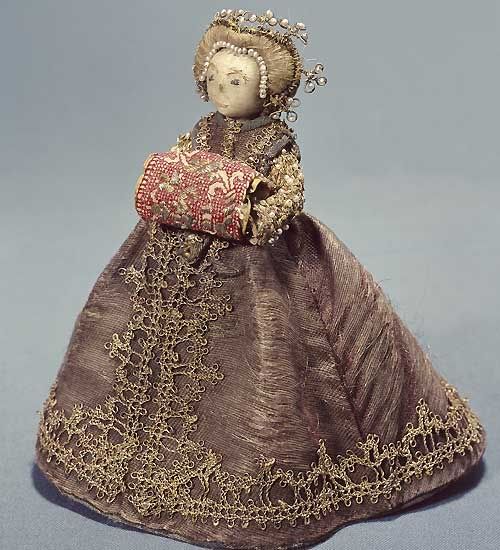I posted a picture of her some years ago, but now she is finally going to be displayed again at Livrustkammaren, the Royal Armoury, at least for a time, so I take the opportunity to show my favourite doll ever. As a kid I wanted her much more than I wanted a Barbie! She is attributed to a daughter of Karl IX, princess Katarina, and may have been made by her, or perhaps just owned. It sems quite likely that she was a fashion doll, made to show of what was fashionable. She is dated to around 1600, which probably made Katarina a bit too old to play with her, as the princess was born in 1584. The doll is also in a very good condition, which makes it a bit unlikely that she was used as a toy. Adorable she is, nevertheless! And my friend Caroline who provided the gorgeous pictures in my last post, has kindly let me use more the following pictures of Pandora as she was unpacked.


She has a body and legs made of wire and skin-coloured silk tread. The gown is made from purple silk, decorated with gold lace. The sleeves are made of red (now faded) silk, embroidered with goldthread and pearls. The muff is also embroidered in red silk and gold- and silverthread.
The first petticoat is in, now brownish, cut and uncut silk velvet decoarted with silver lace. The second is in pink silk taffeta decorated with gold lace. Gown and petticoats are lined. She is just 16 cm tall and wighs 91 gram.
Her face is in pale silk taffeta with eyes, eyebrows, nose and mouth embroidered with silk thread.
The hair is real human hair in a darkish blond shade. The hairstyle is raised around the face, at the back it is pleated and pinned up decoratively. It is decoarted with a row a Pearls at the hairline and a diadem of goldtread and Pearls at the hairstyle's highets Point.
Both dress and hairstyle are vey much in the style of the lats 16th-early 17th Century which makes me think that the hairstyle is quite authentic. This is very nice as one rarely get to see the back of heads on paintings and I have been wondering how there, sometimes quite high hairstyles, looked from behind. The only thing missing is a ruff, but she may have had one that has now disappeared.
A fashion plate from 1595. Apart from the headdress and missing ruff, the gown is very much in the same style as the doll's. There is even a muff!
A range of hairstyle from the decades before and after 1600 which are quite similar to the doll's hair.














































